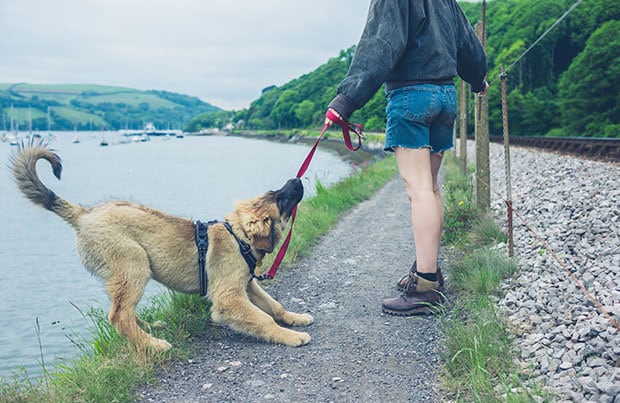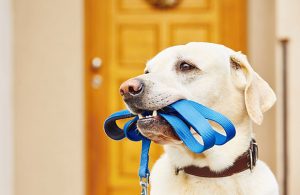We spend a lot of time with a leash between us and our dogs, so it’s important to make daily walks as enjoyable as possible. While we all strive for harmonious leash walks, the reality is that we sometimes accidentally sabotage them, allowing little annoyances to grow into unmanageable problems.
The following common leash mistakes can turn a pleasant stroll into a major bummer, but the good news is with focused attention, occasional dog treats and heaps of praise, you’ll soon be on the path to happier walks.
Allowing Pulling

Dogs pull because it works – they pull, we follow — and before you know, it you’ve got a certified sled dog on your hands. Walking a “puller” can be an uncomfortable chore and, if you have a big dog that pulls, you might be less inclined to walk your dog because it’s painful. “Untraining” a leash puller is a challenge because you’re competing with muscle memory; dogs get used to the idea that tension around their neck means forward progress. The secret to curbing a dedicated puller is to teach your dog that pulling never works, meaning, when he pulls the walk comes to a complete stop.
If your dog circles back to you when you stop, give him a treat when he’s close to you and keep walking. Continue to give him small rewards for maintaining his position beside you as you walk. If he opts to stand at the end of the leash instead of circling back to you, try giving him a “penalty yard” by walking backwards with your dog until he comes to your side, at which point you give him a treat. Then continue walking, giving him occasional treats for remaining close to you without pulling.
Zoning Out

Sure, multiple daily walks can get monotonous and it seems okay to bury your nose in your phone while your dog does his business, but in doing so you miss an excellent opportunity to connect with him. Experiencing the great outdoors should be a shared adventure in which the two of you encounter the world as a team. Plus, staying focused on your dog gives you a chance to praise and reward him when he eliminates in the right spot or walks politely beside you.
When you’re not mindful of what’s going on with your dog during a walk, you might miss potential hazards on the horizon. Imagine what could happen if you’re engrossed in your phone and holding the dog leash loosely when your dog spots a nervous cat on the road ahead! Staying engaged with your dog keeps him safe and it helps to grow the bond between you.
Being Too Strict

There’s something to be said for good manners during a leash walk, but there is such a thing as going too far. Leash walks are recreational times for your dog – a chance to catch up on neighborhood goings-on by sniffing and marking. Requiring that your dog maintain a strict heel on a short leash at your side with no opportunity to sniff and explore the environment turns a pleasant stroll into a military exercise.
Your dog should be able to move freely during walks, not only to find the perfect place to leave his mark, but also to burn off some brain-energy as he discovers what’s happening in his neighborhood. Making your dog act like a show dog during leash walks takes the fun out of the process for him and deprives him of much needed mental exercise.
Ignoring Bad Behavior

It’s important to find a happy medium when it comes to leash walks. You don’t want to be so strict that your dog can’t enjoy the walk, yet you don’t want to allow him to engage in inappropriate behaviors like barking loudly the entire time or snarling at every human, dog and bicycle that goes by. It’s fine to have a “work in progress” dog, where you’re attempting to address problem behaviors with training and management, but it’s unfair to your dog and everyone around you to look the other way as he morphs into the neighborhood menace.
It’s best to start working on leash walking behavioral challenges as soon as you notice problems percolating rather than waiting until your dog makes them a part of his permanent repertoire.
Ignoring Good Behavior

No matter how challenging your leash walks are, your dog probably does a ton of great stuff while you’re out with him. Rather than letting the positive behaviors happen without acknowledgement, tell him you appreciate even the little things! Praise him and give him a treat when he chooses to walk close to you instead of pulling. Tell him he’s a good dog when he gets his business done quickly. Let him know how smart he is when he opts to look up at you instead of barking at the dog across the street. Acknowledging his manners helps him to understand the types of behavior you like and sets him up to repeat those behaviors in the future.
Using the Wrong Equipment

Leash walking tools are simple in theory – all you need is a leash and a collar – but the options are limitless and can be confusing. The two guiding factors when choosing leash walking equipment should be comfort (both human and canine) as well as safety. Choosing a leash that’s too short makes it difficult for your dog to walk without having tension on the leash, which might accidentally encourage pulling, and choosing one that’s too long makes it tough for you to manage it. While flexible leashes seem like an excellent alternative between too long and too short, they’re actually an unsafe option. The thin cord is more likely to snap, it can cause rope burns and lacerations, the locking mechanism can malfunction, and the length of the leash permits your dog to encounter whatever is on the street long before you get there.
The safest leash walking options are a fixed-length leash about six feet long, paired with a flat dog collar (no prong or choke collars) with a strong claps or a buckle.

Victoria Schade is a dog trainer, author & speaker who has contributed to The Washington Post, Martha Stewart, and other publications.
Share:









